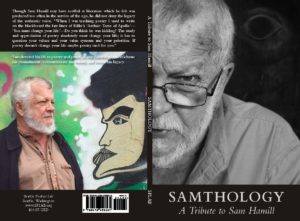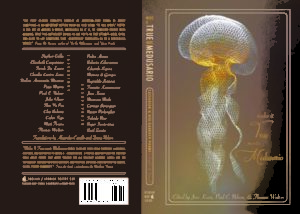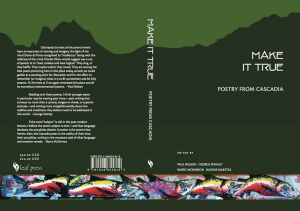Truth Has Fallen in the Street by Edward Smith
It’s an early afternoon in October. I’m in Seattle and I’m winding down from a reading of Truth Has Fallen in the Street, a posthumous publication of Edward Smith’s poems and critical writings. It was put out by Charles Potts’s Temple Inc. earlier this year in a limited run and I’ve got this sense of fortune being able to page through it. Despite the sheen of the cover, it has the look of an important historical text.
The book as a whole is a marvelous introduction into Edward Smith’s world: this seething, writhing poetic universe that encompasses more than the text itself. Before I read it through I skipped through the pages and could tell there would be some great stories and experiences to be had through the verse. But I’ll get to that. As a whole, Truth is a best-of collection of Smith’s work that tries to provide the reader, familiar with Smith or not, with a glimpse into his reality, that layered and complex life driven by his work and art.
Smith died in late 2003 with an assortment of writings that had gone unpublished. Truth opens with Potts providing some biographical history on Smith’s life and process, which is helpful for the foreign reader who was never in touch with the web of Smith’s community, before and during the camp in Washington. Ultimately the presence of community is dominant and crucial to the act of the poetry itself. For better or for worse you don’t need to read the intro to figure out just how substantial biography is. All it takes is a jump into the lines to be confronted with the community.
In the first section of the book (a plethora of “new poems”) is filled with elaborate confessional pieces that tell of Smith’s various travels and escapades. It reads like an AR Ammons or Bill Corbett diary. What I noticed above all else was that Smith was a lover and loved to write about it. He was a lover of people and places and culture. He wrote about what he knew and his poems still resonate just how complicated what he knew was. From quotes on Creeley and Olson, to homages to women and love, the new poems in Truth are subsequently an autobiographical mirror playfully assertive in their narration. The style is founded by the structure, a dichotomy between projective verse and West-coast perceptivity. I could feel Ed Dorn at the reigns. I could feel the pulse of Duncan’s cackles, and the haunting echo of a flattered and flattened Ezra Pound, a chloroformed Gertrude Stein gassing from the mouth.
In “Sweee’Potato Pie & Shut My Mouth” (a new poem) Smith, aroused by projection, commends “what you do marshal/that I can get in line behind/are words & what/they’re turned in/to, like lightning strikes/across unwarranted assumptions/even the nicknames/of your old friends–/did you give them?–/Redboy, Sunshine, Clearlite, Vanish/still flash thru/my dim brain/for all my life since/I met you” . . . The breath and tone, amplified by the short lines and crisp breaks show a pleasant desperation, like a heartbeat, or drum line. It’s a section of the poem’s greater whole that praises those around him, just how important they are, just as important as the reader. As I read the poem the sun was shining through the window and I felt like being jolted awake by Smith’s voice. It was beckoning and telling. When Smith’s newer poems aren’t dragging along on their winding trail, at risk of losing the reader’s interest, they have the ability to capture the reader through the described moment. This is experience. This is the poet telling you: listen to what I just went through, but listen carefully, because it gets tricky.
At other times in his new poems, Edward Smith presents a situation that is cute and humorous but stoic in its sincerity. But let’s ask: just how effective is the writing? In “My Death: Belltown to Bellevue” the typical poet-in-place experience becomes slightly antiquated: “now a lady in shorts/with lots & lots of laundry/asks me/’What cha writin about?’/’I’m writing a poem’/I reply/’Oh, those are complicated’/& I guess they are.” Poets writing poems for other writers to read is always a funky business. Just how important are these anecdotes in Smith’s poetry? Though they struggle to make the poems stick, they provide padding for the more serious business. Smith doesn’t shy away from critical thought, the achievement of beauty, and conveyance of the human experience, which is why his biographical support beams are so necessary.
I’ll hold back from going further into Smith’s meta-poetic personality. Read the book and you’ll find it. Whether you’re into it or not is your own prerogative. But let’s keep going. The book, as I mentioned before, is a compilation of Smith’s work and that doesn’t just include poems he scrawled in the Laundromat or the diner or on some vague, dreamy travel. The second section is composed of eight translations from Chinese poets. The poetry is a blend of old and new: Pound’s Cathay and Rexroth’s later work: most of the poems are recognitions or praises that abound with love and admiration. It’s fascinating to jump from the new poems to the translation because it’s unexpected. The translations are in a completely different style from the individual poems of the first section: the translations’ lengths are shorter and the language more succinct but the presentation on the whole is far more abstract. There is a curious transformation from the beat contractions of his own work and the far more luxurious, beautified catch-all of the Asian masters. There is power and energy that is much more refined, harnessed, and concentrated in these translation poems and it works to set a balance to the spindly and boxy edges of his new poems. The translated poets include Nguyen Du and Du Fu and the second section operates as a buffer to catch rebound after the inauguration of his life’s late style.
Following the translations are “Selections from the Flutes of Gama,” which is a masterful work originally published in the early 70s. While there is a sense in Truth that the reader’s only getting a small chunk of this epic project, the poems that are included are exceptional and exceptionally harrowing. The emotive tissue of these poems isn’t holding back, and this comes as a surprise that keeps the book as a whole turning and turning. There is no mystification in these poems; there is no bending around the point to try and find the symbolic arc. Instead you have abrasive text that shoots you up like a drug, like a dose of reality, like a step up to a social platform.
Take “Hexagram 43: Breakthru” where the poem attacks societal order through those who structure it: “yes, we know/there are creatures/who rule the earth/& sit at lunch with balls/& things like ours between their legs/in suits & order death/& eat it/whole civilization/fought its way down” . . . these lines are remarkably different from the newer poems and from the translations. The sentimentality of the translations is heaped up in the corner. Gone are the rugged hallucinatory clarity of the new poems. The appreciation for love is around but merely hovering at this point in Smith’s chain of art: “I scream & cry & hear her out/she who came/she to whom I came/& come/to owe/the world,/Elaine,/the promise/is ludicrous—“ (from “Flutes of Gama”). I found the third section of the book to be the high point; it is the climax before the cast, before the fall back down toward a hesitation of pretention exhibited through every other piece in the book. “Flutes” isn’t hiding, isn’t waiting to shock you into submission. And I suppose we must ask, why hide anything and if anything is hiding why do we have to make it known?
Every “best of” has its drawbacks. None are perfect because they’re usually overflowing; there’s usually something about them that doesn’t need to be there. The final section of Truth is a typical example. “Critiques” is a series of nine pieces, written in prose and poetry, which could, I suppose, be considered the non-essential look at Edward Smith as a scholar. It’s not so curious as to why it was included if this is the final “book” to display the poet that was and is Edward Smith. But the pieces here are so disconnected from the rest of the book that they’re little more than an annoying send-off. The symbol I’m thinking of is the rose to hit the top of the casket before that dirt starts to pound down, so to speak.
In Smith’s essay-critique of Roethke’s “Dead Geese” there is an overkill of narrow disdain that begs for seriousness to the point of farce. The “Edward Smith Batting Lineup” is a letter sent to Potts regarding the structuring of a book of poems. Whether it’s interesting to you or not depends on how much you care about poems being fantastically compared to baseball. I will grant this final section some merit though: the community that steams out of Smith’s newer poems is verified; however, putting this verification at the end of the book left me with a dry, unsatisfied taste in my mouth. The “Critiques” section is haphazard and random, and the choices of what pieces were included demands additional justification that simply isn’t there.
All in all, the book is a clever and sound inspection of a great poet whose influences I obviously share. I dig the projective verse. I dig the crass tones and the at-times cynical virtue of a poet who embodied his community role. I would be lying if I said it kept me from seeking out more poetry of Smith and Potts and the others involved in the region. At the end of the afternoon, the few flaws with the book as a whole are outweighed by some damn good storytelling, a level of aesthetic that begs a close study of the lines, and a nice wash of publication-ingenuity.
(Greg Bem is a recent arrival from Philadelphia and one of the rotating facilitators of Living Room.)





Pingback: New Review Re-up « The Stale, Continued
Am I allowed to comment here? Having already said enough or too much about Edward Smith. Pressing on I thank Greg Bem for his serious reading of the test and his writing about it. I think his chracterization of the work is valuable, and if the Flutes are the high point, there’s a few copies of it left in the basement. Edward Smith was a nervy poet and a risk taker. Poets trying to compose can discern a lot in his work. Gratzie,
Charles, thanks for checking in.
Hello, I had the good fortune to have Edward Smith as my mentor .He and I worked together in the cemetery business. He is a boss/mentor I will never forget. His deep care for people, and doing the right thing for them was so in line with who I am. He taught me, coached me, and believed in me which is why I became a top producer in such a short amount of time.
I never knew Ed as a poet, but I do know that he was a great man to those of us who were lucky enough to have him as our mentor, and friend. I can speak for many who worked with him that felt as I did. He will always be remembered in a respectful and positive way. Thank you for bringing he poetry to lite he deserved it. I always knew he
was brilliant, but I wasn’t near his level to really understand him, but today as a senior I can see much more of who he was really.